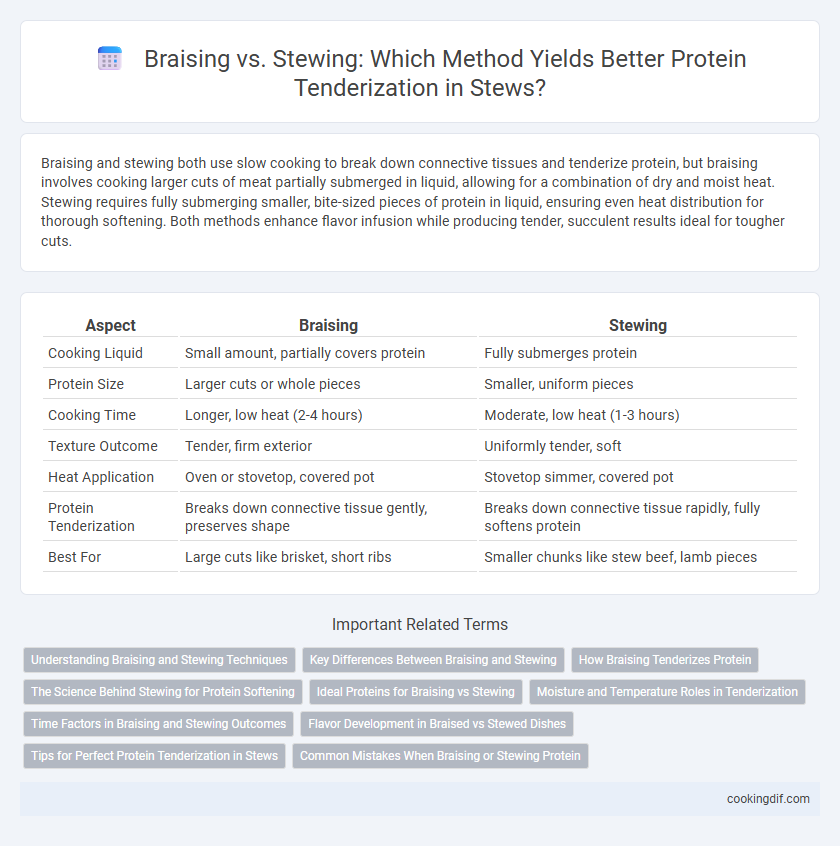Braising and stewing both use slow cooking to break down connective tissues and tenderize protein, but braising involves cooking larger cuts of meat partially submerged in liquid, allowing for a combination of dry and moist heat. Stewing requires fully submerging smaller, bite-sized pieces of protein in liquid, ensuring even heat distribution for thorough softening. Both methods enhance flavor infusion while producing tender, succulent results ideal for tougher cuts.
Table of Comparison
| Aspect | Braising | Stewing |
|---|---|---|
| Cooking Liquid | Small amount, partially covers protein | Fully submerges protein |
| Protein Size | Larger cuts or whole pieces | Smaller, uniform pieces |
| Cooking Time | Longer, low heat (2-4 hours) | Moderate, low heat (1-3 hours) |
| Texture Outcome | Tender, firm exterior | Uniformly tender, soft |
| Heat Application | Oven or stovetop, covered pot | Stovetop simmer, covered pot |
| Protein Tenderization | Breaks down connective tissue gently, preserves shape | Breaks down connective tissue rapidly, fully softens protein |
| Best For | Large cuts like brisket, short ribs | Smaller chunks like stew beef, lamb pieces |
Understanding Braising and Stewing Techniques
Braising and stewing are both moist-heat cooking methods that tenderize tough proteins by breaking down collagen into gelatin. Braising involves cooking larger cuts of meat partially submerged in liquid at low temperatures, allowing slow heat penetration and flavor concentration. Stewing requires smaller, uniformly cut pieces fully immersed in liquid, promoting even cooking and a more uniform tenderization throughout the protein.
Key Differences Between Braising and Stewing
Braising typically involves cooking larger, tougher cuts of protein partially submerged in liquid at low heat, allowing for gradual collagen breakdown and tenderization. Stewing uses smaller pieces fully immersed in liquid, resulting in more uniform cooking and a thicker sauce due to the higher liquid-to-meat ratio. Both methods rely on slow cooking to enhance flavor and tenderness, but braising produces a more concentrated sauce while stewing offers a heartier, stew-like consistency.
How Braising Tenderizes Protein
Braising tenderizes protein by cooking it slowly in a small amount of liquid at low temperatures, allowing collagen in the meat to break down into gelatin, which enhances tenderness and moisture. The combination of heat and moisture softens connective tissues while maintaining structure, resulting in a succulent texture. This method is especially effective for tougher cuts like beef chuck or pork shoulder, transforming them into tender, flavorful dishes.
The Science Behind Stewing for Protein Softening
Stewing breaks down connective tissues in tougher cuts of meat through low and slow cooking in liquid, allowing collagen to convert into gelatin which tenderizes protein fibers. The extended cooking time and consistent moisture prevent protein fibers from contracting, resulting in a soft and juicy texture. Compared to braising, stewing fully submerges meat, maximizing heat transfer and collagen breakdown for optimal protein softening.
Ideal Proteins for Braising vs Stewing
Braising is ideal for larger, tougher cuts of protein like beef brisket, short ribs, and pork shoulder, as the combination of searing and slow cooking in liquid breaks down collagen and connective tissues efficiently. Stewing works best with smaller, uniform pieces of proteins such as chicken thighs, lamb stew meat, or cubed beef, allowing even heat penetration and moisture absorption that tenderizes the protein evenly. Both methods rely on low and slow cooking temperatures, but braising suits dense cuts requiring long cooking times, while stewing is perfect for bite-sized protein chunks needing consistent tenderness.
Moisture and Temperature Roles in Tenderization
Braising and stewing both utilize low, consistent temperatures and extended cooking times to break down collagen in proteins, transforming tough cuts into tender, flavorful dishes. Moisture plays a critical role in both methods; braising typically uses less liquid, partially submerging the protein to maintain a balance between steaming and simmering, while stewing fully immerses the protein in liquid, promoting thorough moisture absorption. Precise control of temperature, usually around 160-180degF (71-82degC), ensures optimal collagen dissolution without overcooking, preserving the protein's texture and enhancing tenderness effectively.
Time Factors in Braising and Stewing Outcomes
Braising typically involves cooking larger cuts of protein at lower temperatures for longer periods, promoting even heat penetration and collagen breakdown, resulting in tender, flavorful meat. Stewing generally uses smaller, uniform pieces of protein cooked fully submerged in liquid over moderate heat, allowing consistent moisture retention and accelerated tenderization due to increased surface area exposure. Time factors in braising or stewing directly influence muscle fiber softening and connective tissue gelatinization, essential for achieving optimal tenderness and texture in both methods.
Flavor Development in Braised vs Stewed Dishes
Braising enhances flavor development by cooking protein slowly in a small amount of liquid, allowing Maillard reactions to intensify the dish's depth and richness. Stewing submerges protein completely in liquid, promoting even tenderness but with a more uniform, less concentrated flavor profile. The reduced liquid in braising concentrates flavors, creating a robust and complex taste compared to the milder, broth-like essence achieved through stewing.
Tips for Perfect Protein Tenderization in Stews
Achieving perfect protein tenderization in stews relies on controlling cooking temperature and time, with braising ideal for larger cuts using low heat and longer cooking to break down collagen into gelatin. Stewing involves submerging smaller, uniform protein pieces in liquid, ensuring even heat penetration and moisture retention for consistent tenderness. Maintaining a gentle simmer and avoiding boiling prevents protein fiber tightening, resulting in a succulent, melt-in-the-mouth texture.
Common Mistakes When Braising or Stewing Protein
Common mistakes when braising or stewing protein include using excessively high heat, which can cause the meat to become tough instead of tender. Another frequent error is insufficient liquid, leading to uneven cooking and drying out the protein. Overcrowding the pot reduces effective heat circulation and prevents proper browning, crucial for flavor and texture development during the slow cooking process.
Braising vs stewing for protein tenderization Infographic

 cookingdif.com
cookingdif.com